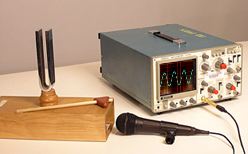A simple sinusoidal sound (tuning fork) and a complex sound (human voice) can be compared (see figure 3).
Materials:
- Tuning fork with a resonator (E3)
- Microphone
- Oscilloscope
- A few student volunteers to speak or sing in the microphone.
- (Optional) Document camera
Demo:

Figure 2: A volunteer speaks into the microphone to display a complex waveform on the oscilloscope.
One can speak into the microphone to show the jagged waveform of a complex sound (Figure 2), while the tuning fork is used to show the consistent sine wave of a simple sound (Figure 3). A document camera is available for displaying the oscilloscope screen to larger audiences.
Explanation:
A simple sound is one which maintains a single frequency, while a complex sound is a combination of multiple frequencies. Tuning forks are precise instruments that vibrate at a single frequency/note as a result of their construction, so the oscilloscope displays a constant sinusoid when the tuning fork is struck. A human voice does not use a precise metal instrument, rather, it uses the organic tissue of the larynx, which is powered by the lungs and from this multitude of factors produces a sound which is comprised of many overlaying independent frequencies. The comparatively complex system of the human vocal folds makes for a waveform which is not comprised of a simple sinusoid, but of many sinusoids which combine to form an ever changing waveform.
Notes:
- Be sure to carefully adjust the oscilloscope so it displays a viewable waveform.
Written by: Alek Beck

